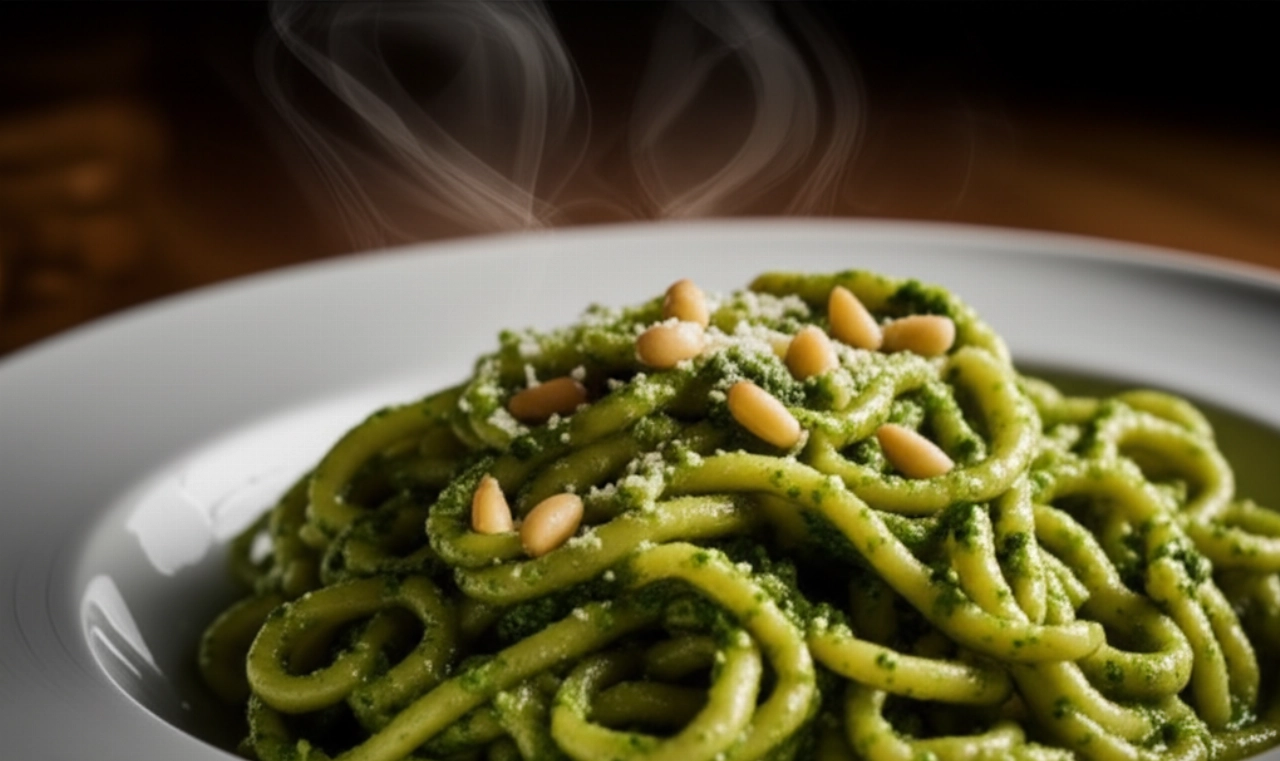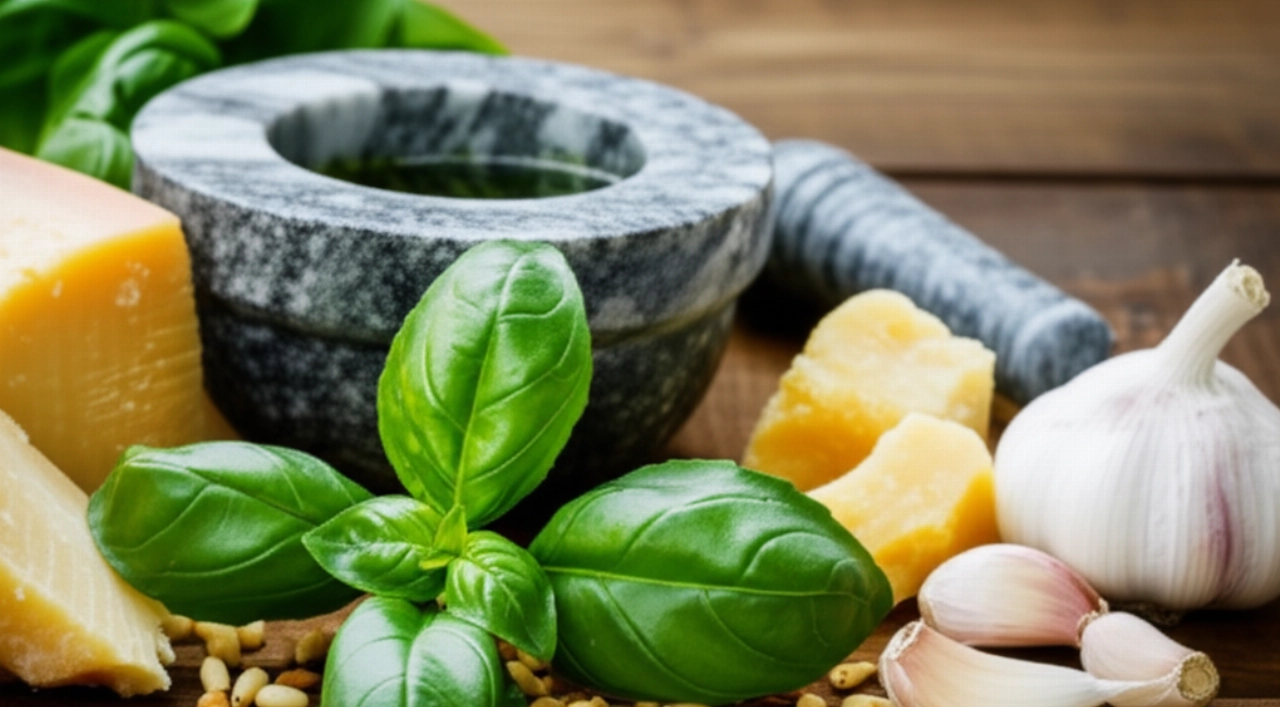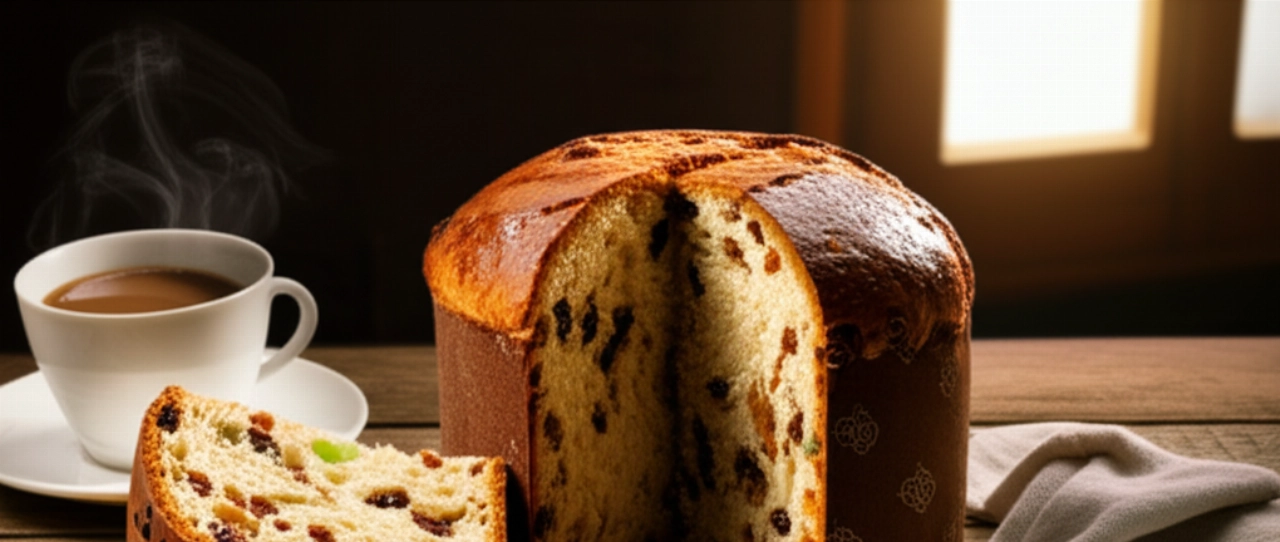Dreaming of bringing to the table a pasta dish enveloped in pesto so green, fresh, and fragrant that it transports you directly to the sunny hills of Liguria? A pesto that is not just a condiment, but a true hymn to tradition, an embrace of authentic flavors that captivates at first taste?
Too often, however, the dream clashes with reality: pesto turns dark, bitter, or even worse, tastes "cooked" and loses all its magic. Finding the true recipe, one that guarantees success and the authentic flavor of a Ligurian grandmother, can seem like a challenge.
Make yourself comfortable. On this page, you won't just find a list of ingredients, but the definitive guide, full of tricks and tips, to prepare the best and most authentic Genoese Pesto Pasta of your life. I will reveal the secrets for a vibrant, highly fragrant, and bright green pesto, with or without a mortar, that will make you feel like a true chef. Success is guaranteed, and compliments will not be long in coming!
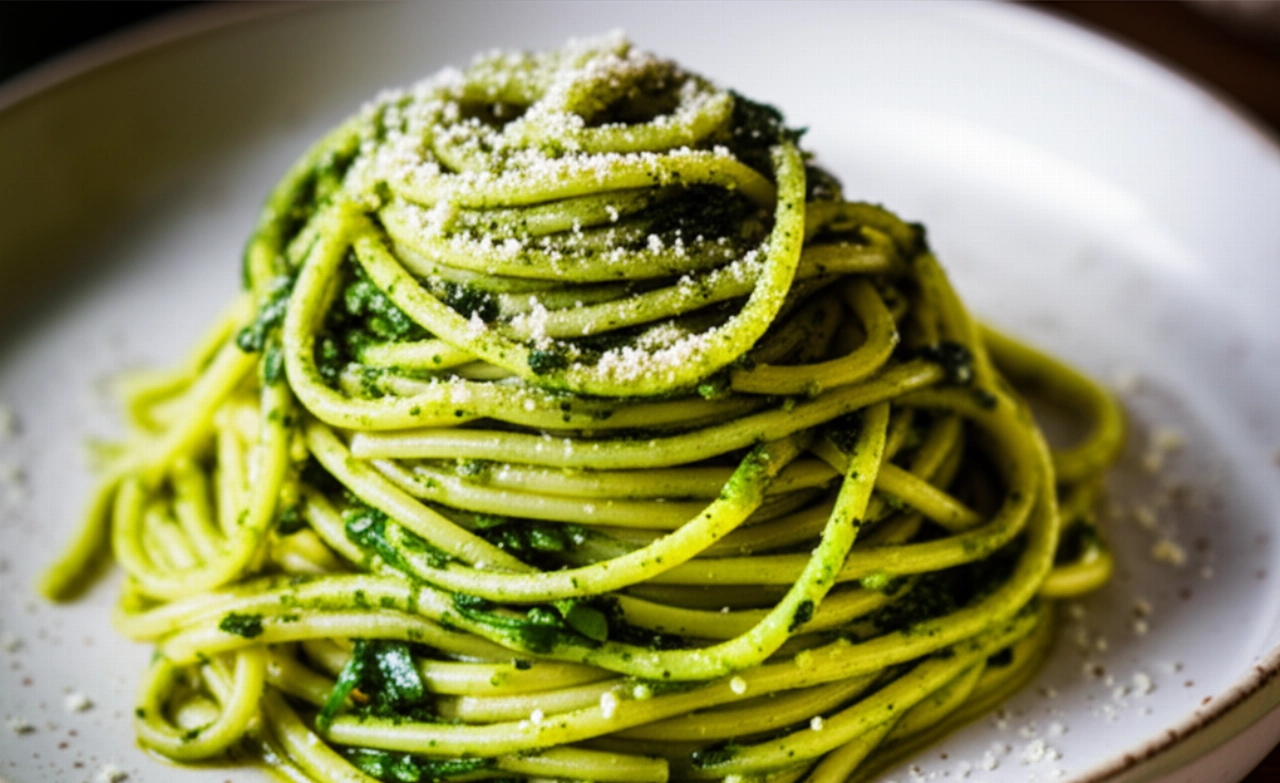
Ingredients for a Perfect Genoese Pesto: The Choice That Makes the Difference
The secret to an extraordinary pesto begins with the quality of the ingredients. It's not just a list, but a reasoned selection; every element has its purpose.
- Genoese Basil PDO: It's the soul of pesto. Choose small, tender, bright green leaves, preferably grown in Liguria. They have a more delicate aroma and less minty hint compared to other varieties. Do not wash them under running water, but gently clean them with a damp cloth.
- Pine Nuts: They must be fresh and of good quality. Do not toast them! Their sweet and buttery flavor must balance the freshness of the basil, not overpower it.
- Parmigiano Reggiano and Pecorino Sardo: A wise mix of these two aged cheeses is essential. Parmigiano (at least 24 months) gives sweetness and complexity, Pecorino (Sardo, not Romano, which is too salty) adds a more decisive and pungent note. Balance is key.
- Garlic: A small clove, possibly from Vessalico, and always deprived of its "soul" (the central germ). This will make it less aggressive and more digestible, without covering the basil's aroma.
- Extra Virgin Olive Oil: Choose a Ligurian oil, delicate and fruity, with very low acidity. It must bind the ingredients without overpowering their flavors. It is the vehicle of fragrance.
- Coarse Sea Salt: Don't underestimate the salt! In the mortar, it helps to "rub" the basil leaves, extracting their essential oils without oxidizing them.
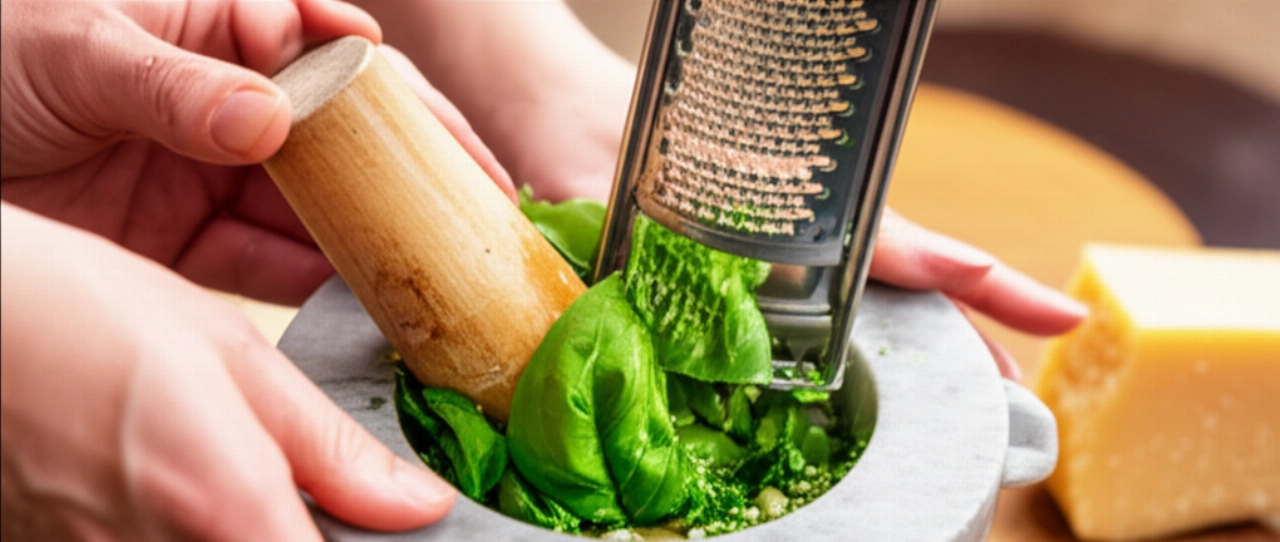
The 3 Mistakes That Make Pesto Dark and Bitter (and How to Avoid Them)
I've seen the dream of perfect pesto shatter too many times due to small, but crucial, mistakes. Here's how to avoid them and ensure a flawless result:
- Heat, the Enemy of Basil: Basil is very delicate. If you use a blender, do not run it for too long or at high speed. The heat generated by the blades "cooks" the basil, oxidizing it and making it dark and bitter. Blend in very short pulses, almost "tapping," and if necessary, put the blender jar in the freezer for 10 minutes before starting, or add an ice cube.
- Overpowering Garlic: Too much garlic, or garlic not deprived of its "soul," can ruin the balance of the pesto, leaving an unpleasant aftertaste. Be sparing and careful with the preparation of the clove.
- Oxidation in Ambush: Air is the enemy of pesto. Once ready, pesto tends to oxidize and darken quickly. To slow down this process, always cover it with a layer of extra virgin olive oil before storing it in the refrigerator.
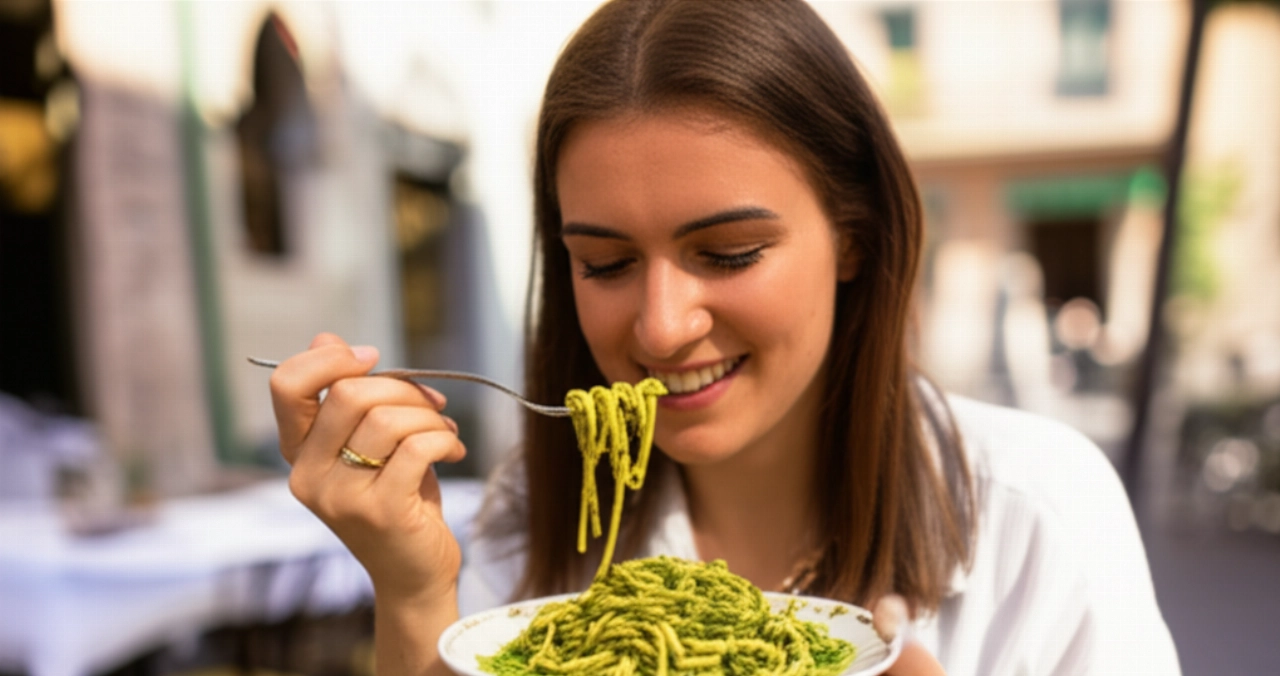
The Extra Touch: The Advice My Grandmother Passed Down to Me
My grandmother, with her wise hands, always taught me that true pesto is not just a recipe, but a sensory experience. She used to tell me: "You must feel the pesto. The scent of basil must fill your soul, and the sound of the pestle in the mortar must be music."
Her secret, besides patience and love, was a little trick for the mortar: always start with garlic and coarse salt. The salt, with its granularity, helps to "break" the fibers of the garlic and then the basil, releasing the essential oils delicately, without tearing the leaves. It's an ancient gesture that makes the difference between a good pesto and an unforgettable pesto.
Let's Prepare Pesto Pasta Together: The Step-by-Step Guide
Traditional Method (with Mortar)
- Prepare the ingredients: Gently clean the basil with a damp cloth. Weigh all ingredients. Roughly chop the cheeses.
- Start with the mortar: Place the garlic clove (without its "soul") and a few grains of coarse salt in the mortar. Begin to pound with circular and firm movements until you get a cream.
- Add the basil: Add the basil leaves, a few at a time, and continue to pound with rotating movements, pressing the leaves against the sides of the mortar. Do not "crush" but "rub" gently. You will feel an intoxicating aroma rise.
- Pine nuts and cheeses: When the basil is well pounded, add the pine nuts and continue to work. Then incorporate the grated cheeses, mixing well with the pestle.
- The oil, in a stream: Finally, add the extra virgin olive oil in a slow stream, mixing with the pestle until you obtain a homogeneous and shiny cream.
Quick Method (with Blender)
If you don't have a mortar, you can use a blender, but be careful not to heat the basil.
- Prepare the blender: Place the blender jar in the freezer for 10-15 minutes.
- Blend the ingredients: Put the garlic (without its "soul"), coarse salt, pine nuts, and basil leaves into the cold jar. Add an ice cube (optional, but recommended to maintain color).
- Add cheeses and oil: Operate the blender in very short pulses, for a few seconds at a time, scraping the sides if necessary. When the basil is chopped, add the cheeses and oil in a stream, continuing to blend in pulses until the desired consistency is achieved.
The Perfect Pasta with Pesto
- Choose your pasta: Trofie, trenette, or bavette are the quintessential Ligurian pastas, perfect for collecting pesto.
- Cooking: Cook the pasta in plenty of salted water.
- Toss: Drain the pasta al dente, reserving some of the cooking water. Transfer the pasta to a large bowl (or directly into the pot, but off the heat). Add the pesto and one or two tablespoons of the pasta cooking water. Mix well, tossing, until the pesto coats every single piece of pasta in a velvety cream.
- Serve immediately: Plate and serve immediately, perhaps with a few fresh basil leaves for garnish.
Tips and Frequently Asked Questions about Pesto Pasta
Here are some of the most common questions I get asked about pesto, with answers that will help you clear any doubts.
- Can I use only Parmigiano or only Pecorino? You can, but the mix of the two cheeses offers a balance of flavors and a complexity that a single cheese cannot provide. If you absolutely must choose, use only Parmigiano for a more delicate pesto.
- How can I store leftover pesto? You can store it in the refrigerator for 3-4 days, in an airtight container and covered with a thin layer of extra virgin olive oil to prevent oxidation. For longer storage, you can freeze it in jars or single portions (for example, in ice cube trays).
- Why does my pesto turn dark? Primarily due to oxidation from contact with air or excessive heat during preparation (especially with a blender). Follow the blender tips and always cover the pesto with oil.
- What is the right amount of garlic? It depends on your personal taste, but for an authentic and balanced pesto, a small clove (without its "soul") for about 50-70g of basil is ideal. If you don't like garlic, you can omit it, but be aware that you will lose some of the original character.
- Can I add potatoes and green beans to pesto pasta? Absolutely yes! It's a beloved Ligurian tradition. Cook potatoes and green beans together with the pasta in the last few minutes of cooking, then drain them and dress everything together with the pesto.
There you have it! Now you no longer have just a recipe, but all the secrets to bring to the table a dish that tastes of home, tradition, and love. A dish that will make you feel proud and receive sincere applause.
Don't be afraid to experiment and add your personal touch. Cooking is a gesture of creativity and generosity. But start from this solid base, and you'll see that success will be guaranteed.
Have you tried our recipe? We are very curious to see your masterpiece! Leave a comment below, tell us how it went, or share a photo on Instagram by tagging @CercaRicette.it. If you loved this pesto, you can't miss our recipe for the Fresh Tomato Pasta, another timeless classic, or the Original Genoese Focaccia to accompany your Ligurian meal!
